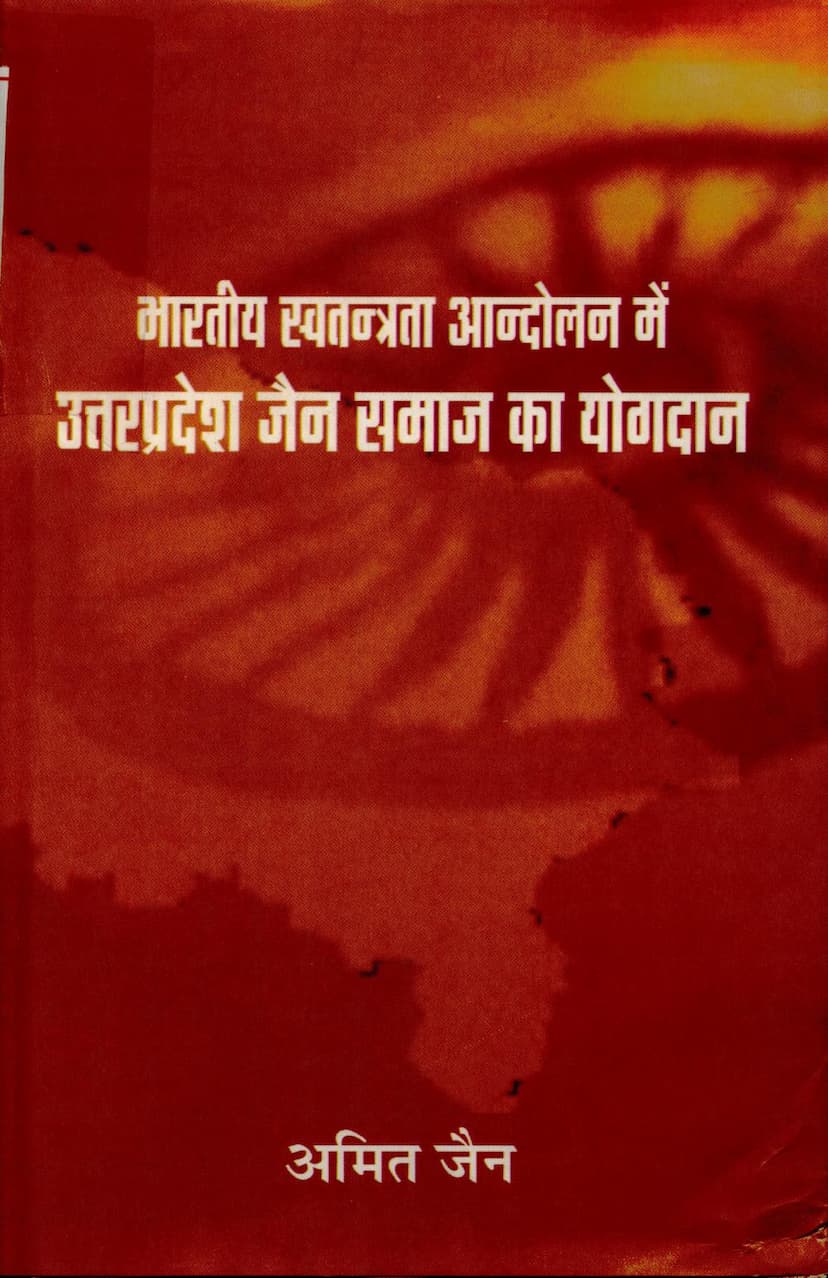Bhartiya Swatantrata Andolan Me Uttar Pradesh Jain Samaj Ka Yogdan
Added to library: September 1, 2025

Summary
The book "Bhartiya Swatantrata Andolan Me Uttar Pradesh Jain Samaj Ka Yogdan" (Contribution of the Jain Community of Uttar Pradesh in the Indian Freedom Movement) by Amit Jain, published by Bharatiya Gyanpith, delves into the significant, yet often overlooked, role of the Jain community in Uttar Pradesh during India's struggle for independence.
Here's a comprehensive summary based on the provided text:
Core Theme: The book highlights the active participation and substantial contributions of the Jain community in Uttar Pradesh to the Indian freedom struggle from 1919 to 1947. It aims to bring to light the sacrifices and efforts of numerous Jain individuals who fought for the nation's independence, many of whom remain relatively unknown in mainstream historical accounts.
Key Aspects Covered:
- Broad Participation: The Jain community, despite its relatively small population in Uttar Pradesh, played a significant role across various phases and movements of the freedom struggle, including the Non-Cooperation Movement, Civil Disobedience Movement, and the Quit India Movement.
- Influence of Jain Principles: The book emphasizes how Jain principles, particularly Ahimsa (non-violence), deeply influenced their participation. Mahatma Gandhi himself drew inspiration from Jain philosophy, making Ahimsa a central tenet of the freedom movement.
- Economic, Social, and Political Contributions: The book details the multifaceted contributions of the Jain community:
- Economic: Jain families were involved in trade and industry, contributing to the nation's economic development. Notable contributions are made by families like the Shahu Jain family and individuals like Shahu Shantiprasad Jain and Shahu Shreyans Prasad Jain, who were prominent industrialists. Seth Achalsingh Jain and others are also mentioned for their efforts in promoting industries and addressing unemployment.
- Social: The Jain community established numerous educational institutions (schools, colleges, gurukuls), hospitals, charitable trusts, and publication houses. Figures like Shraman Ganeshprasad Varni and Brahmachari Sitalprasad are highlighted for their social reform and educational initiatives. The book details the extensive network of educational institutions run by the Jain community in districts like Muzaffarnagar, Saharanpur, Meerut, and Bijnor.
- Political: Many Jain individuals actively participated in the political arena, holding positions at regional and national levels. Prominent names include Ajitprasad Jain, Sumatprasad Jain, Shrimati Lekhwati Jain, Babu Ratanlal Jain, Nemisharan Jain, and Seth Achalsingh Jain, who served in legislative councils, assemblies, and even Parliament, contributing to policy-making and the freedom struggle.
- Participation in Major Movements:
- Non-Cooperation Movement (1919-1922): Jain individuals actively participated, boycotting institutions, returning titles, and facing imprisonment. The Jain Political Conference played a role in strategizing their involvement.
- Civil Disobedience Movement (1930 onwards): Jains participated in breaking salt laws, picketing liquor shops, and promoting Khadi. Many faced arrests and served jail sentences. Figures like Sumatprasad Jain, Umarao Singh Jain, and Ramchandra Jain are mentioned.
- Quit India Movement (1942): The Jain community played a significant role, with many participating in protests, facing arrests, and even engaging in acts of sabotage against government property, as detailed in the extensive chapter on this movement.
- Role of Jain Press and Literature: The book acknowledges the crucial role of Jain newspapers and magazines like 'Jain Gazette,' 'Jain Mitra,' 'Jain Sandesh,' 'Veer,' 'Digambar Jain,' 'Anekant,' and 'Veer Sandesh' in spreading patriotic messages, promoting Swadeshi, and raising national consciousness. These publications often faced government bans and pressure but continued their work.
- Literary Contributions: Talented Jain writers like Rishabcharan Jain, Jainendra Kumar, Yashpal Jain, Akshaykumar Jain, and Shanti Swaroop Jain 'Kusum' used their writings (stories, novels, poems) to awaken nationalistic sentiments, criticize social injustices, and inspire the public towards the freedom struggle. Their works often depicted revolutionary themes and the sacrifices of freedom fighters.
- Involvement in Revolutionary Activities: Beyond peaceful protests, some Jain individuals were involved in more direct revolutionary activities. Vimalprasad Jain from Baghpat is highlighted for his role in the Delhi Conspiracy Case and the establishment of a bomb factory. His family also contributed significantly to these efforts.
- Support to Azad Hind Fauj: The Jain community also extended support to Netaji Subhas Chandra Bose's Azad Hind Fauj, with individuals like Col. Dr. Rajmal Jain serving in critical medical capacities and Jain saints like Ganeshprasad Varni making personal sacrifices to aid the cause.
- Combating Social Evils: Alongside the freedom struggle, the Jain community actively worked to eradicate social evils like animal sacrifice, child marriage, and caste discrimination, further contributing to the societal upliftment essential for national progress.
Methodology: The author, Amit Jain, conducted extensive research, gathering information from government documents, public relations departments, national archives, libraries, and conducting interviews with freedom fighters and their families.
Overall Significance: The book aims to fill a gap in historical narratives by documenting the contributions of the Jain community in Uttar Pradesh to the Indian freedom movement. It underscores that this community, though numerically small, was deeply committed to the cause of India's independence, demonstrating significant courage, sacrifice, and dedication. The work serves as an important historical record and an inspiration for future generations.